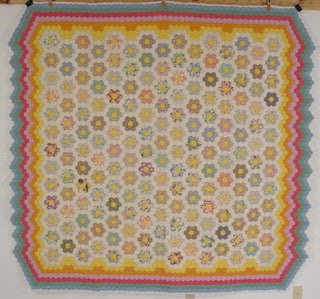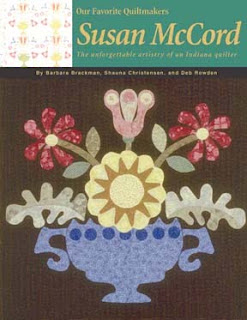Hexagon patchwork from about 1830 with the papers and the basting still in them.
Susan wants to know:
Are quilts with paper templates “quilted”? Are they stitched---quilted through the layers? Are they quilted around the pieces? Are they tied or are they just backed and unquilted? It seems they would need to be held together some how especially with the added weight of the paper. I guess some women removed the paper but it seems most I’ve seen are unfinished.
It depends.
In England, 19th-century quiltmakers (note I didn't say quilters) often left the papers in and they finished off the edges to make what we might call a summer spread---an unquilted top.
Early 19th century British medallion
See more about it at: http://www.oldfashionedstuff.co.uk/id12.html
Early 19th-century, quilted hexagon medallion
See more about this terrific quilted version at Betsy Telford-Goodwin's web site:http://www.rockymountainquilts.com/files/antiquequilt_btcefp.php
The later in the century, the more likely the hexagon quilts were to have been quilted and to have been pieced with a running stitch rather than to have been pieced over papers with a whip stitch.
Detail of a quilt top in the 1890s or so, probably pieced in conventional running stitch
Quilted hexagon quilt from 1860-1890
Some hexagon quilts from recent online auctions
This one from the late 19th century is made of wools, silks, blends, etc.
It looks pretty heavy, yet it's quilted close to the seam with a tiny red stitch.
When the hexagon idea became a new fad in the 1930s, nobody used paper and they quilted their Grandmother's Flower Gardens.
Grandmother's Flower Garden from the 1930s.
Quilters usually quilted around each hexagon.
See a rather fancy 30's version by clicking here:
http://www.nebraskahistory.org/images/sites/mnh/quilts_a_z/8027-16.jpg

This British medallion with appliqued rosettes was shown at Houston's Quilt Festival last fall. It's not quilted at all, as far as I can tell.
Susi at Susi's Quilts found it online and was inspired to make a reproduction. I had seen it the year before in an online British auction. See more Houston pictures at Virginia Cole's Galloping Pony blog.
Watch Susi's progress here:




gBLjwvfCcYQ~~_3.jpg)

















































